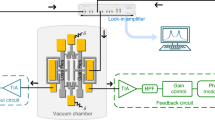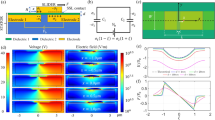Abstract
Wireless sensors based on micromachined tunable resonators are important in a variety of applications, ranging from medical diagnosis to industrial and environmental monitoring. The sensitivity of these devices is, however, often limited by their low quality (Q) factor. Here, we introduce the concept of isospectral party–time–reciprocal scaling (PTX) symmetry and show that it can be used to build a new family of radiofrequency wireless microsensors exhibiting ultrasensitive responses and ultrahigh resolution, which are well beyond the limitations of conventional passive sensors. We show theoretically, and demonstrate experimentally using microelectromechanical-based wireless pressure sensors, that PTX-symmetric electronic systems share the same eigenfrequencies as their parity–time (PT)-symmetric counterparts, but crucially have different circuit profiles and eigenmodes. This simplifies the electronic circuit design and enables further enhancements to the extrinsic Q-factor of the sensors.
This is a preview of subscription content, access via your institution
Access options
Access Nature and 54 other Nature Portfolio journals
Get Nature+, our best-value online-access subscription
$29.99 / 30 days
cancel any time
Subscribe to this journal
Receive 12 digital issues and online access to articles
$119.00 per year
only $9.92 per issue
Buy this article
- Purchase on Springer Link
- Instant access to full article PDF
Prices may be subject to local taxes which are calculated during checkout





Similar content being viewed by others
Change history
24 May 2018
In the version of this Article originally published, a division symbol was mistakenly omitted from both of the y axis labels in Fig. 5a. The label in the left panel should have read ‘Re((ω×ω0)/2π) (MHz)’ and the label in the right panel should have read ‘Im((ω×ω0)/2π) (MHz)’. This has now been corrected.
References
Nopper, R., Niekrawietz, R. & Reindl, L. Wireless readout of passive LC sensors. IEEE Trans. Instrum. Meas. 59, 2450–2457 (2010).
Collins, C. C. Miniature passive pressure transensor for implanting in the eye. IEEE Trans. Biomed. Eng. 2, 74–83 (1967).
Pozar, D. M. Microwave Engineering 4th edn (John Wiley & Sons, New York, 2012).
Mokwa, W. Medical implants based on microsystems. Meas. Sci. Technol. 18, R47–R57 (2007).
Chavan, A. V. & Wise, K. D. Batch-processed vacuum-sealed capacitive pressure sensors. J. Micro. Syst. 10, 580–588 (2001).
Chen, P. J., Rodger, D. C., Saati, S., Humayun, M. S. & Tai, Y. C. Microfabricated implantable parylene-based wireless passive intraocular pressure sensors. J. Micro. Syst. 17, 1342–1351 (2008).
Chen, L. Y. et al. Continuous wireless pressure monitoring and mapping with ultra-small passive sensors for health monitoring and critical care. Nat. Commun. 5, 5028 (2014).
Huang, H., Chen, P. Y., Hung, C. H., Gharpurey, R. & Akinwande, D. A zero power harmonic transponder sensor for ubiquitous wireless μL liquid-volume monitoring. Sci. Rep. 6, 18795 (2016).
Yvanoff, M. & Venkataraman, J. A feasibility study of tissue characterization using LC sensors. IEEE Trans. Antenna Propagat. 57, 885–893 (2009).
Bender, C. M. & Boettcher, S. Real spectra in non-Hermitian Hamiltonians having P T symmetry. Phys. Rev. Lett. 80, 5243 (1998).
Makris, K. G., El-Ganainy, R., Christodoulides, D. N. & Musslimani, Z. H. Beam dynamics in PT symmetric optical lattices. Phys. Rev. Lett. 100, 103904 (2008).
Rüter, Ch. E. et al. Observation of parity–time symmetry in optics. Nat. Phys. 6, 192–195 (2010).
Regensburger, A. et al. Parity–time synthetic photonic lattices. Nature 488, 167–171 (2012).
Lin, Z. et al. Unidirectional invisibility induced by PT-symmetric periodic structures. Phys. Rev. Lett. 106, 213901 (2011).
Mostafazadeh, A. Invisibility and PT symmetry. Phys. Rev. A 87, 012103 (2013).
Longhi, S. PT-symmetric laser absorber. Phys. Rev. A 82, 031801 (2010).
Chong, Y. D., Ge, L. & Stone, A. D. PT-symmetry breaking and laser-absorber modes in optical scattering systems. Phys. Rev. Lett. 106, 093902 (2011).
Feng, L., Wong, Z. J., Ma, R. M., Wang, Y. & Zhang, X. Single-mode laser by parity-time symmetry breaking. Science 346, 972–975 (2014).
Hodaei, H., Miri, M. A., Heinrich, M., Christodoulides, D. N. & Khajavikhan, M. Parity–time-symmetric microring lasers. Science 346, 975–978 (2014).
Wong, Z. J. et al. Lasing and anti-lasing in a single cavity. Nat. Photon. 10, 796–801 (2016).
Lee, J. M. et al. Reconfigurable directional lasing modes in cavities with generalized PT symmetry. Phys. Rev. Lett. 112, 253902 (2014).
Peng, B. et al. Parity–time-symmetric whispering-gallery microcavities. Nat. Phys. 10, 394–398 (2014).
Ramezani, H., Kottos, T., El-Ganainy, R. & Christodoulides, D. N. Unidirectional nonlinear PT-symmetric optical structures. Phys. Rev. A 82, 043803 (2010).
Chang, L. et al. Parity-time symmetry and variable optical isolation in active-passive-coupled microresonators. Nat. Photon. 8, 524–529 (2014).
Schindler, J., Li, A., Zheng, M. C., Ellis, F. M. & Kottos, T. Experimental study of active LRC circuits with PT symmetries. Phys. Rev. A 84, 040101 (2011).
Schindler, J. et al. PT-symmetric electronics. J. Phys. A 45, 444029 (2012).
Bender, N. et al. Observation of asymmetric transport in structures with active nonlinearities. Phys. Rev. Lett. 110, 234101 (2013).
Fleury, R., Sounas, D. & Alù, A. An invisible acoustic sensor based on parity–time symmetry. Nat. Commun. 6, 5905 (2015).
Lu, X. Y., Jing, H., Ma, J. Y. & Wu, Y. PT-symmetry-breaking chaos in optomechanics. Phys. Rev. Lett. 114, 253601 (2015).
Xu, X. W., Liu, Y. X., Sun, C. P. & Li, Y. Mechanical PT symmetry in coupled optomechanical systems. Phys. Rev. A 92, 013852 (2015).
Wiersig, J. Sensors operating at exceptional points: general theory. Phys. Rev. A 93, 033809 (2016).
Chen, P. Y. & Jung, J. PT-symmetry and singularity-enhanced sensing based on photoexcited graphene metasurfaces. Phys. Rev. Appl. 5, 064018 (2016).
Liu, Z. P. et al. Metrology with PT-symmetric cavities: enhanced sensitivity near the PT-phase transition. Phys. Rev. Lett. 117, 110802 (2016).
Chen, W., Özdemir, Ş. K., Zhao, G., Wiersig, J. & Yang, L. Exceptional points enhance sensing in an optical microcavity. Nature 548, 192–196 (2017).
Hodaei, H. et al. Enhanced sensitivity at higher-order exceptional points. Nature 548, 187–191 (2017).
Acknowledgements
This work has been supported by the NSF ECCS grant no. 1711409 (to P.-Y.C.), the Air Force Office of Scientific Research, the Welch Foundation with grant no. F-1802 (to A.A.) and the Army Research Office (ARO) grant no. W911NF-17-1-0481 (to R.E.-G.). Device fabrication was carried out in the Nano Fabrication Service Core (nFab) at the Wayne State University.
Author information
Authors and Affiliations
Contributions
M.S., M.H. and Q.C. designed the PT and PTX circuits and performed experimental measurements. M.S., M.H., Q.C. and M.C. designed and fabricated the MEMS pressure sensor. P.-Y.C., M.S. and M.C. conceived the experimental concepts. P.-Y.C., M.C., R.E.-G. and A.A. developed the concepts. P.-Y.C. and A.A. planned and directed the research. P.-Y.C., R.E.G. and A.A. wrote the manuscript.
Corresponding authors
Ethics declarations
Competing interests
The authors declare no competing interests.
Additional information
Publisher’s note: Springer Nature remains neutral with regard to jurisdictional claims in published maps and institutional affiliations.
Supplementary information
Supplementary Information
Supplementary Notes 1–3 and Supplementary Figures 1–10
Rights and permissions
About this article
Cite this article
Chen, PY., Sakhdari, M., Hajizadegan, M. et al. Generalized parity–time symmetry condition for enhanced sensor telemetry. Nat Electron 1, 297–304 (2018). https://doi.org/10.1038/s41928-018-0072-6
Received:
Accepted:
Published:
Issue Date:
DOI: https://doi.org/10.1038/s41928-018-0072-6
This article is cited by
-
Exceptional points enhance sensing in silicon micromechanical resonators
Microsystems & Nanoengineering (2024)
-
Advances in Wireless, Batteryless, Implantable Electronics for Real-Time, Continuous Physiological Monitoring
Nano-Micro Letters (2024)
-
Analysis of Hermitian and non-Hermitian diabolic points and exceptional rings in parity-time symmetric ZRC and RLC dimers
Optical and Quantum Electronics (2024)
-
Machine learning for knowledge acquisition and accelerated inverse-design for non-Hermitian systems
Communications Physics (2023)
-
Spectral sensitivity near exceptional points as a resource for hardware encryption
Nature Communications (2023)



